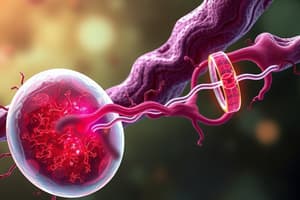Podcast
Questions and Answers
In cellular respiration, carbon dioxide is formed from the oxidation of which of the following?
In cellular respiration, carbon dioxide is formed from the oxidation of which of the following?
glucose
Which molecule is produced in the oxidation of NADH during fermentation?
Which molecule is produced in the oxidation of NADH during fermentation?
lactate
What are the final by-products of glucose oxidation during aerobic cellular respiration? (Select all that apply)
What are the final by-products of glucose oxidation during aerobic cellular respiration? (Select all that apply)
- Water (correct)
- ATP (correct)
- Heat (correct)
- Lactate
- Carbon dioxide (correct)
Which of the following processes will occur in the presence or absence of oxygen?
Which of the following processes will occur in the presence or absence of oxygen?
What molecule's buildup indicates that muscles are functioning anaerobically?
What molecule's buildup indicates that muscles are functioning anaerobically?
Lactate is produced during yeast fermentation.
Lactate is produced during yeast fermentation.
How do the products of glycolysis and the Krebs cycle relate to the electron transport chain?
How do the products of glycolysis and the Krebs cycle relate to the electron transport chain?
Why is cellular respiration important?
Why is cellular respiration important?
Oxygen is a product of the electron transport chain.
Oxygen is a product of the electron transport chain.
The first stage of cellular respiration, called ___________, takes place in the cytoplasm of the cell and needs no oxygen.
The first stage of cellular respiration, called ___________, takes place in the cytoplasm of the cell and needs no oxygen.
Under what environmental conditions do yeast carry out fermentation?
Under what environmental conditions do yeast carry out fermentation?
What does cellular respiration do?
What does cellular respiration do?
What is produced when beer is made?
What is produced when beer is made?
Which of the following is not a reaction that cells use to get energy from nutrients? (Select one)
Which of the following is not a reaction that cells use to get energy from nutrients? (Select one)
What do yeast cells produce under anaerobic conditions?
What do yeast cells produce under anaerobic conditions?
Which are true statements about anaerobic respiration? (Select all that apply)
Which are true statements about anaerobic respiration? (Select all that apply)
The two types of cellular respiration are: (Select all that apply)
The two types of cellular respiration are: (Select all that apply)
What are the types of anaerobic respiration?
What are the types of anaerobic respiration?
Select the correct statements about cellular respiration. (Select all that apply)
Select the correct statements about cellular respiration. (Select all that apply)
When trying to determine the rate of cellular respiration (an aerobic process), why is oxygen measured and not carbon dioxide?
When trying to determine the rate of cellular respiration (an aerobic process), why is oxygen measured and not carbon dioxide?
Flashcards are hidden until you start studying
Study Notes
Cellular Respiration Overview
- Cellular respiration oxidizes glucose to produce ATP, essential for cellular functions.
- Oxygen serves as a terminal electron acceptor in aerobic respiration.
By-products of Cellular Respiration
- Final by-products include ATP, heat, carbon dioxide, and water.
- In anaerobic respiration, products vary based on the organism (e.g., lactate in muscles, ethanol in yeast).
Glycolysis
- Glycolysis occurs in the cytoplasm and does not require oxygen.
- It produces energy carriers, including NADH, that shuttle electrons to the electron transport chain.
Fermentation
- Fermentation occurs in the absence of oxygen, resulting in lactate in muscles or ethanol and carbon dioxide in yeast.
- Yeast cells under anaerobic conditions produce ethyl alcohol (ethanol) and carbon dioxide.
Anaerobic vs. Aerobic Respiration
- Anaerobic respiration can produce products like lactate and ethanol, and occurs entirely in the cytoplasm.
- Aerobic respiration generates more ATP compared to anaerobic respiration, utilizing oxygen as a reactant.
Energy Monitoring in Sports
- Monitoring lactate buildup helps assess muscle function and anaerobic activity during intense exercise.
Types of Cellular Respiration
- The two primary types are aerobic respiration, which requires oxygen, and anaerobic respiration, which occurs without it.
Importance of Oxygen Measurement
- Measuring oxygen, not carbon dioxide, is crucial for determining the rate of aerobic respiration to distinguish it from anaerobic processes.
Key Reactions and Equations
- Overall equation for cellular respiration: C6H12O6 + 6O2 → 6CO2 + 6H2O + 36 ATP.
- Photosynthesis is not a reaction used for energy extraction from nutrients in cellular respiration.
Studying That Suits You
Use AI to generate personalized quizzes and flashcards to suit your learning preferences.



